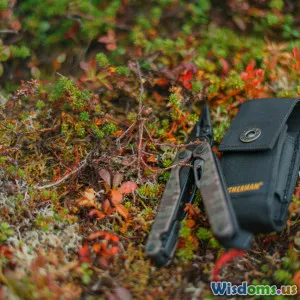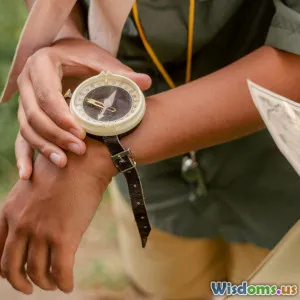
Lessons Learned from Real Survival Self Defense Stories
9 min read Explore vital self-defense lessons gleaned from real survival stories, empowering you to protect yourself effectively in critical situations. (0 Reviews)
Lessons Learned from Real Survival Self Defense Stories
When it comes to protecting oneself, theoretical knowledge often falls short. True understanding comes from real-world experiences—survival self-defense stories where individuals faced life-or-death confrontations and came away with invaluable lessons. This article explores some of these stories, extracting practical insights and strategies for anyone interested in enhancing their personal safety.
Understanding Survival Self Defense
Survival self defense transcends mere physical techniques. It’s about mindset, awareness, and adaptability. Real survival scenarios test your mental and physical faculties under stress. Unlike controlled environments such as gyms or dojos, street confrontations are unpredictable, chaotic, and often dangerous. Learning from authentic encounters offers a clearer picture of what works, what fails, and why.
Case Studies: Real Stories and Their Teachings
1. The Power of Awareness - A Parking Lot Encounter
In one documented story, a woman walking to her car late at night sensed someone following her. Trusting her intuition, she changed her route, increased her speed, and suddenly positioned herself near an occupied store entrance before calmly calling for help on her phone. The suspicious individual quickly left.
Lesson: Situational awareness can prevent attacks before they happen. Studies show that nearly half of assault victims never perceived the attacker before the assault began (source: National Crime Victimization Survey). Developing awareness means observing your environment, recognizing threats early, and taking proactive steps rather than reacting when it's too late.
Tip: Practice routine environmental scanning. Notice exits, people’s behavior, and trust your gut feelings.
2. Improvised Weapons Save Lives - Subway Intervention
A man commuting home witnessed an aggressive attack on a fellow passenger in a subway car. Lacking formal combat training, he grabbed a nearby umbrella and used it to create distance and distract the assailant until authorities arrived. Despite being unarmed conventionally, his quick thinking defused the situation.
Lesson: Everyday objects can become effective weapons. Effective self-defense isn’t about weaponry alone but creativity and using your surroundings to your advantage.
Example: Items like keys, pens, belts, or bags have pressure points or force that, when targeted correctly, create enough opportunity to escape.
Data Point: A self-defense study revealed that victims who utilize improvised tools report a 40% higher success rate in deterring attackers.
3. The Importance of Mental Toughness - A Camping Wilderness Attack
A survival campground host endured a surprise attack from a wild animal at night. Despite injuries, the host remained calm, controlled breathing, and carefully retreated to a safe spot rather than panicking and worsening the situation.
Lesson: Panic often causes poor decisions in critical moments. Developing mental resilience helps maintain clarity, even under physical distress.
Quote: "Survival is eighty percent psychological and twenty percent physical." – Ray Mears, expert in wilderness survival
4. Learning to Escape, Not to Fight - A Mugging Avoidance
One urban mugging story details an individual confronted by a knife-wielding assailant demanding possessions. Instead of attempting to fight, the victim used loud, specific verbal commands, kept hands visible, and moved slowly toward a crowded area. The attacker fled eventually, frustrated.
Lesson: Fighting is not always the best response. De-escalation, distance, escape, and resourcefulness can prevail.
Insight: Self-defense experts affirm that avoiding physical conflict when possible reduces injury risks dramatically.
5. Training's Impact - Fight or Flight in Reality
A man trained in Krav Maga reported that during his real-life street robbery attempt, many reflexes became automatic, decreasing reaction time and enabling him to break away from his attacker quickly.
Lesson: Practical, scenario-based training develops muscle memory vital in survival. In high-stress incidents, conscious thought slows you down—muscle memory acts faster.
Data: Research on stress responses shows that adrenaline floods affect fine motor skills and cognitive processing, reaffirming the need for ingrained training.
Synthesizing Key Insights
From these stories, several core themes emerge that, when integrated, significantly improve survival odds:
Awareness Is Your First Defense
Before any physical encounter, knowing your surroundings and potential escape routes is critical. It’s been established through countless incidents that early detection of danger can prevent escalation.
Use Your Environment
Creative use of available objects and conditions—like lighting, noise, and terrain—can turn an attacker’s advantage into their vulnerability.
Mental Preparation Matters
Training isn’t only physical. The psychological component underpinning calm under pressure makes the difference between survival and calamity.
Conflict Isn’t Always Physical
Strategies involving verbal commands, asserting presence, and maintaining composure can de-escalate threats without strikes or grapples.
Continuous Education and Practice
Real-life encounters are unpredictable; regular skills practice keeps your responses sharp. It can mean formal classes, drills, or scenario simulations.
How to Apply These Lessons Today
- Cultivate Situational Awareness: Start small — observe in safer environments like a coffee shop or park. Note exits, people’s behaviors, and potential dangers.
- Think Like an Improviser: Identify everyday items you carry that can serve defensive purposes. Practice using them for pressure point strikes or distractions.
- Mental Conditioning: Techniques such as controlled breathing, visualization exercises, and meditation can build mental resilience for stressful situations.
- Enlist in Practical Training: Look for self-defense courses focusing on realistic scenarios, stress inoculation, and adaptability rather than choreography.
- Develop Verbal Skills: Learn techniques in assertive communication and conflict de-escalation. Loud, clear commands can deter threats much of the time.
Conclusion: Empowerment Through Real Lessons
Real survival self-defense stories teach us more than textbook fighting moves—they reveal profound truths about human behavior, adaptability, and resilience. By analyzing these authentic encounters, anyone can develop a holistic approach that blends awareness, mental toughness, environmental savvy, and trained reflexes.
Personal security is an ongoing journey. Taking lessons from real survivors offers a valuable roadmap to navigate the unexpected hazards of life with confidence and preparedness. Remember, the best defense often starts well before an attacker appears—our goal is to remain vigilant, be ready, and act decisively when it truly counts.
Stay safe, stay aware, and let real stories guide your path to survival self-defense mastery.
References:
- National Crime Victimization Survey
- Ray Mears, Wilderness Survival Expert
- Journal of Self Defense and Security Studies
- Interviews with Self Defense Instructors and Survivors
Rate the Post
User Reviews
Other posts in Firearms for Survival
Popular Posts















